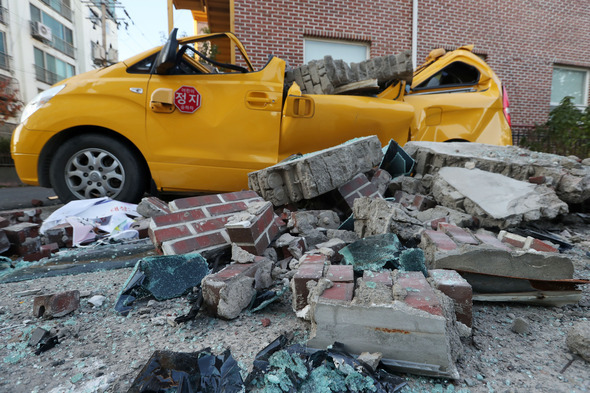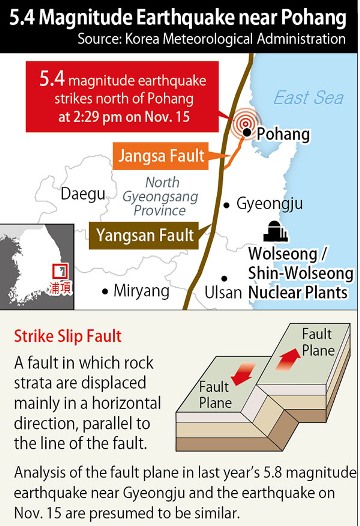 |
|
The epicenter of a 5.4 magnitude earthquake that struck on Nov. 15 was 9km north of Pohang’s Buk District. The quake destroyed the wall of a preschool, which crushed the school’s bus parked on the street outside after it fell. (Yonhap News)
|
Quakes are increasing in the region housing most of the country’s nuclear plants
A little over a year after the Gyeongju earthquake, South Korea is being swept once again by the fear of earthquakes. The tremors were felt around the country, including Seoul. With the two most powerful earthquakes in Korean history occurring in the space of a year in the southeastern region – which contains the world’s highest concentration of nuclear reactors – concerns are increasing about the series of earthquakes. There is also growing interest in how the repeated earthquakes in the region will impact the government’s future policy for nuclear power. “An earthquake measuring 5.4 in magnitude occurred at an area 9km north of Buk District, Pohang, North Gyeongsang Province, at 2:29:31 this afternoon,” the Korea Meteorological Administration (KMA) announced on Nov. 15. This was the second most powerful earthquake in Korean history, following the 5.8-magnitude earthquake that struck Gyeongju on Sept. 12, 2016. There were two foreshocks, with a magnitude of 2.2 and 2.6, that occurred in the same region before the earthquake. After the main shock, 26 aftershocks with at least a magnitude of 2.0 (the most powerful measured 4.3) had occurred as of 8:20 pm. The KMA urged residents to be cautious, since the aftershocks could continue. The Pohang earthquake occurred at the southeastern fault zone, an area where stress has built up for a long time, and geologists are considering the possibility that this earthquake was triggered by a combination of the Great East Japan Earthquake in 2011 and by the Gyeongju earthquake last year, which was affected by the previous earthquake. This earthquake could affect neighboring fault lines, triggering yet another quake. In the aftermath of the earthquake, South Korea’s College Scholastic Ability Test (CSAT), which had been scheduled for Nov. 16, was delayed one week, to Nov. 23. “After inspecting all 14 of the test sites around Pohang, we found cracks in a large number of the test buildings, including Daedong High School. To ensure the safety of those sitting for the test and the fairness of the CSAT, we have decided to delay it until Nov. 23, one week from now,” said Deputy Prime Minister for Social Affairs and Education Minister Kim Sang-gon in an emergency press conference held at 8:20 pm. The earthquake caused a great commotion as shocked residents of Pohang and other cities rushed out of buildings. While the magnitude of this earthquake was lower than the one that struck Gyeongju last year, it occurred at a more shallow level, 9km below the surface of the earth, making the tremors very perceptible. Roads in some parts of Pohang cracked in two, while the walls of buildings collapsed, crushing parked cars.
 |
|
5.4 Magnitude Earthquake near Pohang
|







